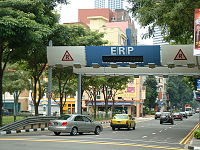Congestion pricing

Congestion pricing is like a kind of toll for cars to drive on busy roads. Imagine if you go to a theme park and you have to pay more if you want to go on a ride faster. It's like that, but for cars.
Let's say you want to drive on a street that's always busy and has a lot of traffic. Maybe it's rush hour, or maybe it's just a really popular road. Normally, you can drive on it for free because it's a public road. But with congestion pricing, you have to pay extra if you want to use that road during busy times.
Think of it like this: the road is a toy store, and there are only a certain number of toys for sale. If too many kids come into the store at the same time, there won't be enough toys for everyone. But if the store charged MORE money for the toys during really busy times, some kids might decide it's not worth it to buy a toy right then, and they'll come back later when it's not as busy.
So, when you hear about 'congestion pricing,' it means that the road has a certain price that changes depending on how busy it is. The hope is that, by charging more during peak hours, fewer people will want to drive on that road at those times. This way, there will be less traffic and everyone can get where they're going faster. Plus, the money from the congestion pricing can be used to make public transportation better, which could encourage even more people to take buses or trains instead of driving.
In summary, congestion pricing is a way of charging more for using busy roads during peak hours to reduce traffic congestion, improve the efficiency of transportation, and generate revenue for public transportation.
Let's say you want to drive on a street that's always busy and has a lot of traffic. Maybe it's rush hour, or maybe it's just a really popular road. Normally, you can drive on it for free because it's a public road. But with congestion pricing, you have to pay extra if you want to use that road during busy times.
Think of it like this: the road is a toy store, and there are only a certain number of toys for sale. If too many kids come into the store at the same time, there won't be enough toys for everyone. But if the store charged MORE money for the toys during really busy times, some kids might decide it's not worth it to buy a toy right then, and they'll come back later when it's not as busy.
So, when you hear about 'congestion pricing,' it means that the road has a certain price that changes depending on how busy it is. The hope is that, by charging more during peak hours, fewer people will want to drive on that road at those times. This way, there will be less traffic and everyone can get where they're going faster. Plus, the money from the congestion pricing can be used to make public transportation better, which could encourage even more people to take buses or trains instead of driving.
In summary, congestion pricing is a way of charging more for using busy roads during peak hours to reduce traffic congestion, improve the efficiency of transportation, and generate revenue for public transportation.
Related topics others have asked about:
